I am afraid I am stuck with an estimation problem.
I have two variables, X and Y. Y is explained by the weighted sum of n lagged values of X. My aim is to estimate the two parameters c(alpha0,alpha1) in:
Yt = Sum from j=1 to n of ( ( alpha0 + alpha1 * j ) * Xt-j )

Where Xt-j denotes the jth lag of X.
I came up with this approach because I thought it would be a good idea to estimate the slope of the weights rather than estimating one parameter for each lag of X added (I intent to set n very large).
To the model noise ut is added, which is assumed to be normally distributed with mean zero and standard deviation sigma.
Assuming I would like to set n=510, then I need the original series and 510 lagged series. In order to avoid any NAs in the series I transform the original data to "data_chopped", containing only the observations after the first 510 observations have been dropped, and the matrix "data_lagged" in which each column represents a lagged series:
library(stats)
data<-arima.sim(n=10000,list(ar=0.15,ma=0.1),mean=0.5)
data_chopped<-data[511:length(data)]
data_lagged<-matrix(nrow=length(data_chopped),ncol=510)
for (i in 1:510){
data_lagged[,i]<-head(data,-i)[(511-i):length(head(data,-i))]
}
#Check result:
cbind(data_chopped,data_lagged[,1:3])
#data_lagged[,1] is the first lag of the original data, data_lagged[,2] is the second lag, and so on. No NAs whatsoever to deal with
To demonstrate the "working order" of my log-likelihood function and the generated series I first would like to fit an AR(3) model:
logl<-function(sigma,alpha,beta,gamma){
-sum(log((1/(sqrt(2*pi)*sigma)) * exp(-((
data_chopped
-alpha*data_lagged[,1]
-beta*data_lagged[,2]
-gamma*data_lagged[,3]
)^2)/(2*sigma^2))))
}
library(stats4)
mle(logl,start=list(sigma=1,alpha=0,beta=0,gamma=0),method="L-BFGS-B")
When I now try to estimate my model in the same way it just does not work. I never got a loop within a log-likelihood function to work, this is why I just wrote out the above model. So,
Yt = Sum from j=1 to n of ( ( alpha0 + alpha1 * j ) * Xt-j )
= (alpha+beta*1)*Xt-1 + (alpha+beta*2)*Xt-2 + (alpha+beta*3)*Xt-3 + ... + (alpha+beta*510)*Xt-510
logl<-function(sigma,alpha,beta){
-sum(log((1/(sqrt(2*pi)*sigma)) * exp(-((
data_chopped
-(alpha + beta*1)*data_lagged[,1]
-(alpha + beta*2)*data_lagged[,2]
-(alpha + beta*3)*data_lagged[,3]
-(alpha + beta*4)*data_lagged[,4]
-(alpha + beta*5)*data_lagged[,5]
...
-(alpha + beta*510)*data_lagged[,510]
)^2)/(2*sigma^2))))
}
library(stats4)
mle(logl,start=list(sigma=1,alpha=0.5,beta=0),method="L-BFGS-B")
Error in optim(start, f, method = method, hessian = TRUE, ...) :
L-BFGS-B needs finite values of 'fn'
I do not get the error if I try just a very few lines:
logl<-function(sigma,alpha,beta){
-sum(log((1/(sqrt(2*pi)*sigma)) * exp(-((
data_chopped
-(alpha + beta*1)*data_lagged[,1]
-(alpha + beta*2)*data_lagged[,2]
-(alpha + beta*3)*data_lagged[,3]
-(alpha + beta*4)*data_lagged[,4]
-(alpha + beta*5)*data_lagged[,5]
)^2)/(2*sigma^2))))
}
library(stats4)
mle(logl,start=list(sigma=1,alpha=0.5,beta=0),method="L-BFGS-B")
Call:
mle(minuslogl = logl, start = list(sigma = 1, alpha = 0.5, beta = 0),
method = "L-BFGS-B")
Coefficients:
sigma alpha beta
1.07797708 0.26178848 -0.04378526
Can someone please help me out on this?